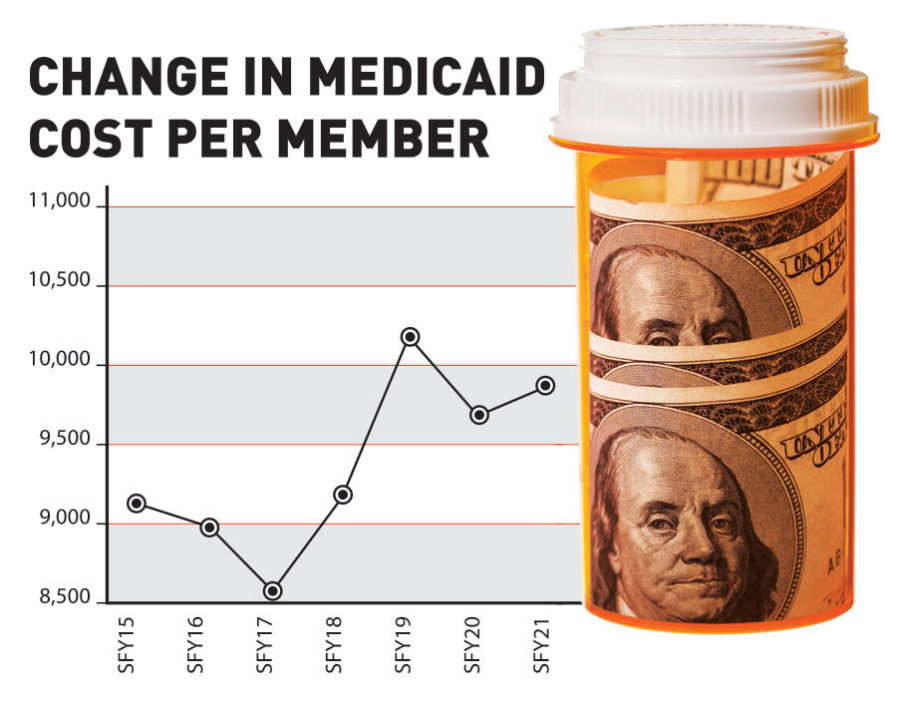2018 sees Medicaid costs nearly triple, report shows
November 13, 2018
Medicaid recipients saw the highest premium costs ever since 2015, when former-Gov. Terry Branstad relinquished control of the program to private companies. Data released by the Iowa Department of Human Services showed rates increased in 2018 at nearly triple the rate of past years.
However, the effect of this wasn’t universal. While recipients saw elevated costs, not everyone paid triple their former premiums. Some people paid less than that, but others like Debra Pratt paid more.
In 2018, Pratt will pay an additional $3,600 in Medicaid premium costs. This doesn’t incorporate the $1,300 for her husband’s medical costs or his healthcare premiums. Pratt said she feels like she’s “being screwed over.”
“Last year I paid around $86 dollars a month for Medicaid,” Pratt said. “This year I’m paying $386 every month. Plus I have to help pay for my husbands healthcare costs.”
Pratt’s husband, Tracy Pratt, is a retired factory worker and cancer survivor. He suffered from liver cancer, which has since gone into remission, but his doctor’s say it could come back at any time. His monthly pension isn’t enough to cover the payments.
“He’s on a transplant list right now,” Pratt said. “His Medicaid doesn’t cover nearly as much as it used to. He needs an MRI every three months to make sure the cancer isn’t back, and that costs us more than $300 each time. It used to be much less.”
Healthcare was one of the biggest issues going into the Iowa midterm elections. Gov. Kim Reynolds admitted the system needs changes but said the system was still an improvement overall. In the debates, she said other healthcare systems “weren’t sustainable.”
However, those on the Democratic side criticized this healthcare plan. Reynold’s former opponent, Fred Hubbell, said he would return control of Medicaid to the state. J.D. Scholten, a former candidate for congress in Iowa’s 4th District, said the only real solution was Medicare for All.
“The cost of healthcare has gone up while accessibility has gone down,” Scholten said. “The privatization of Medicaid has been a disaster … and the long term solution is Medicare for All.”
Scholten lost the campaign for the 4th District to incumbent Rep. Steve King by 3 percent. However, Scholten’s campaign resulted in the closest race since King’s been in office.
Pratt is 60 years old and has worked as a hotel manager for 20 years. She worked the last 10 years in Ames. She said she was hoping on retiring in the coming years, but the increased payments she has to cover means she might not retire until her seventies. Her current employer doesn’t offer any health insurance.
She also said her husband’s doctor’s appointments cost around $40 for each individual visit, and her husband goes to the doctor a lot, Pratt said.
Healthcare was one of the top concerns in the Iowa midterm elections, as it was across the nation. Polls from AP and NBC revealed it was the number one concern on voters minds, just ahead of immigration.
According to Iowa State Political Science Professor Mack Shelley, Pratt’s experiences are the natural results of Medicaid privatization.
“In some cases you’ll have people dying or becoming very ill as a consequence,” Shelley said.
He said Reynold’s healthcare solutions coupled with her plans to continue tax cuts could result in thinner funds for other.
“If you cut taxes and have to increase payments to private providers, it’s hard to see how the arithmetic works out,” Shelley said. “Increased payments are going to have to be taken out of someone else’s hide, like public education. Money would have to be taken out of other parts of the state budget to account for it.”
However, Pratt doesn’t think it’s Medicaid privatization that’s causing her elevated costs. After all, premium payments did drop in 2017, the first full year with the privatization plan implemented. She thinks the program doesn’t focus enough on the elderly.
“I’m not so sure it’s because of privatization,” Pratt said. “It’s about who’s getting access to the benefits. A lot of the people on Medicaid are children, and young parents with children.”
Pratt is right about Medicaid enrollment. The data shows 58 percent of people on Medicaid are children, another 16 percent are adults and only 8 percent of recipients are elderly citizens. However, those statistics aren’t reflective of Medicaid spending. Only 20 percent of Medicaid expenditures went to children in 2018, 12 percent went to adults and 19 percent went to the elderly.
The data shows that children and the elderly account for similar healthcare expenses despite the disparity in Medicaid membership. However, Pratt insisted that Medicaid should focus more on caring for the elderly people who’ve worked their entire lives, but can’t afford the high premium costs.
“I’m worried about the people that can’t pay, Pratt said, “the people that are too old for work. They’ve already worked and paid into the system, and they’re getting left behind. It would be better if young people could have jobs that allowed them to afford insurance that didn’t cut into care for the elderly.”
She also pointed out that health insurance is expensive, and that a lot needs to change for things to improve.
“A lot of the elderly can’t afford these payments, and young people too,” Pratt said. “I have a son that’s making $12 an hour, and he can’t afford insurance living off of that.”







